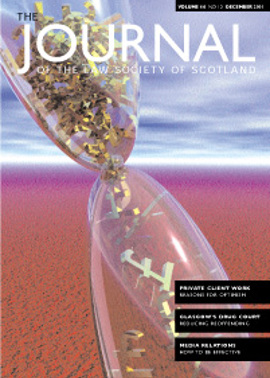Generating profits in larger firms
In last month’s Journal article John McCutcheon and Andrew Otterburn* discussed the performance of the smaller firms who had participated in The 2001 Survey of Law Firms. This month they consider the larger firms – those with five or more profit-sharing partners, concluding that a better support staff ratio is likely to result in lower costs per fee earner.
This year has seen a further increase in the number of participants to 325 firms – the highest number in the history of the survey, and representing a quarter of firms in Scotland – 55 of these firms have five or more partners.
Eighteen firms were from Edinburgh, nine from Glasgow and six from Aberdeen, Dundee or Perth. The remaining 22 firms were in smaller towns, although none of these had more than nine partners. This last group is referred to as “country” in the report.
As the chart indicates those firms with 5-9 partners were earning very similar pre-tax before profit levels to smaller practices – a median of £59,000 per profit-sharing partner compared to £53,000 for 2-4 partner firms. 25% of the 5-9 partner firms were earning over £68,000 per partner.
Note: The mid point, or median, is the middle value in the range and is not influenced by the magnitude of the extreme values (as the average is). The 25% and 75% points indicate the range of values. 25% of firms are below the 25% point, and 25% of firms are above the 75% point. These points are also known as the “lower quartile” and “upper quartile” respectively.
The big difference in results occurred for firms with over ten partners where median pre-tax profits per profit-sharing partner were over £138,000, with 25% of firms achieving over £175,000. The real change probably occurs in firms with more than twenty partners, and next year’s survey may consider this group separately for the first time.
The survey indicates that median profits for 5-9 partner firms increased from £51,000 last year to £59,000 this year. For firms with ten or more partners the corresponding increase was from £86,000 last year to £138,000. However, this may reflect changes in the relatively small sample for this category of firms.
The particular difference between the 10+ partner firms and other firms lay in their “gearing” ratios – the number of other fee earners in addition to the profit-sharing partners, as indicated in the chart:
For larger firms this better gearing is likely to result in a greater proportion of work being undertaken by less senior fee earners. This is likely to result in a higher level of fee income per profit-sharing partner, where the median is over £400,000 for the largest firms as indicated in the chart:
The firms with ten or more partners also had fewer support staff per fee earner – just over one other person (secretaries, cash room etc.) compared with one and a half persons in all other categories of firms.
This better support staff ratio is likely to result in lower costs per fee earner.
Two conclusions in particular can be drawn from the survey concerning larger firms:
- Below a certain level you do not necessarily make more money by being larger – indeed some of the most profitable firms are sole principals in rural areas;
- As would be expected, the most profitable firms are some of the large city firms who are able to attract certain types of commercial work not normally available to many smaller firms. They are also profitable however because of some of the working practices they follow and their ability to assign work to the most appropriate fee earner.
All participating firms have been sent a free copy of “The 2001 Survey of Law Firms in Scotland”, the detailed report upon which this article is based. Other firms can purchase a copy of the full report which contains a wide range of useful statistics and performance indicators. Priced at £80, this is available from Lisa Anderson at the Society on 0131 476 8164.
In April next year the President will be writing to all firms inviting them to participate in the 2002 survey. Participation is free and carries a two hour CPD credit as well as a copy of the survey report. In recent years there has also been a prize draw. This year the prize – of a theatre weekend in London – was won by Friels, a three partner firm based in Uddingston. The Society is again grateful to Alex Quinn for sponsoring the prize in 2001.
* John McCutcheon, until his recent retirement, was Professor of Actuarial Studies in the department of Actuarial Mathematics and Statistics at Heriot-Watt University. He is a member of the Society’s Remuneration Committee and, since 1980, has conducted the annual Cost of Time Survey.
Andrew Otterburn is a management consultant and contributor to Update courses on practice management. His book on the Profitability and Financial Management of legal practices is published by the Law Society in London.
In this issue
- President’s report
- Bright future in private client work
- Generating profits in larger firms
- The Glasgow drug court
- Time to think again
- Navigating the media maze
- Legal aid for employment tribunals – at last
- Winning pitches, or learning when to shut up
- All I want for Christmas is some PKI – I think
- Time for fundamental review of children’s evidence
- Risks in advising spouses – the Etridge effect
- European update
- Book reviews






